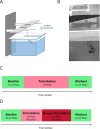The archerfish uses motor adaptation in shooting to correct for changing physical conditions
- PMID: 38829209
- PMCID: PMC11147504
- DOI: 10.7554/eLife.92909
The archerfish uses motor adaptation in shooting to correct for changing physical conditions
Abstract
The archerfish is unique in its ability to hunt by shooting a jet of water from its mouth that hits insects situated above the water's surface. To aim accurately, the fish needs to overcome physical factors including changes in light refraction at the air-water interface. Nevertheless, archerfish can still hit the target with a high success rate under changing conditions. One possible explanation for this extraordinary ability is that it is learned by trial and error through a motor adaptation process. We tested this possibility by characterizing the ability of the archerfish to adapt to perturbations in the environment to make appropriate adjustments to its shots. We introduced a perturbing airflow above the water tank of the archerfish trained to shoot at a target. For each trial shot, we measured the error, i.e., the distance between the center of the target and the center of the water jet produced by the fish. Immediately after the airflow perturbation, there was an increase in shot error. Then, over the course of several trials, the error was reduced and eventually plateaued. After the removal of the perturbation, there was an aftereffect, where the error was in the opposite direction but washed out after several trials. These results indicate that archerfish can adapt to the airflow perturbation. Testing the fish with two opposite airflow directions indicated that adaptation took place within an egocentric frame of reference. These results thus suggest that the archerfish is capable of motor adaptation, as indicated by data showing that the fish produced motor commands that anticipated the perturbation.
Keywords: Snell's law; adaptation; archerfish; neuroscience; toxotes.
© 2023, Volotsky et al.
Conflict of interest statement
SV, OD, RS No competing interests declared
Figures





Update of
- doi: 10.1101/2023.10.03.560658
- doi: 10.7554/eLife.92909.1
- doi: 10.7554/eLife.92909.2
Similar articles
-
Archerfish foraging success varies with immediate competition level but not group size.Behav Ecol. 2024 May 21;35(4):arae040. doi: 10.1093/beheco/arae040. eCollection 2024 Jul-Aug. Behav Ecol. 2024. PMID: 38813400 Free PMC article.
-
Archerfish use their shooting technique to produce adaptive underwater jets.J Exp Biol. 2017 Mar 15;220(Pt 6):1019-1025. doi: 10.1242/jeb.146936. Epub 2017 Jan 12. J Exp Biol. 2017. PMID: 28082614
-
Archerfish coordinate fin maneuvers with their shots.J Exp Biol. 2021 Apr 15;224(8):jeb233718. doi: 10.1242/jeb.233718. Epub 2021 Apr 26. J Exp Biol. 2021. PMID: 33785500
-
What a predator can teach us about visual processing: a lesson from the archerfish.Curr Opin Neurobiol. 2018 Oct;52:80-87. doi: 10.1016/j.conb.2018.04.001. Epub 2018 May 1. Curr Opin Neurobiol. 2018. PMID: 29727858 Review.
-
Archerfish vision: Visual challenges faced by a predator with a unique hunting technique.Semin Cell Dev Biol. 2020 Oct;106:53-60. doi: 10.1016/j.semcdb.2020.05.017. Epub 2020 Jun 7. Semin Cell Dev Biol. 2020. PMID: 32522409 Review.
Cited by
-
Object identity representation occurs early in the archerfish visual system.Sci Rep. 2025 Feb 3;15(1):4102. doi: 10.1038/s41598-025-88660-7. Sci Rep. 2025. PMID: 39900793 Free PMC article.
-
Whole Body Motor Adaptation in Goldfish Using Fish Operated Vehicle.Eur J Neurosci. 2025 Sep;62(5):e70241. doi: 10.1111/ejn.70241. Eur J Neurosci. 2025. PMID: 40897372 Free PMC article.
References
MeSH terms
Grants and funding
LinkOut - more resources
Full Text Sources

